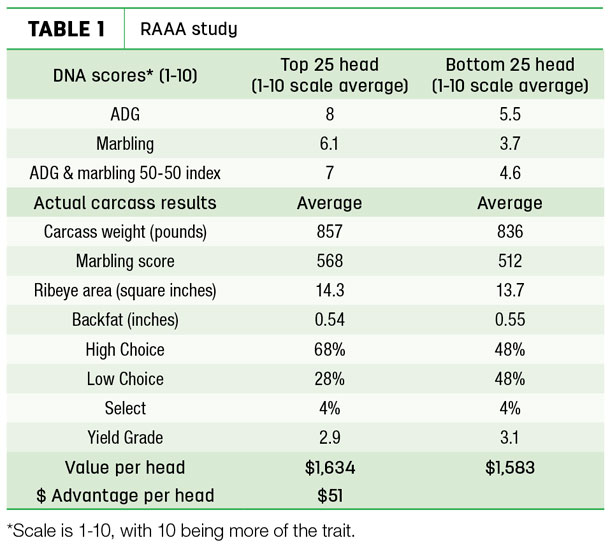Today, cow-calf producers have new DNA technologies, which also can create value on their own ranch and in the finishing phase.
These beef genomics tools, which have helped predict future performance of breeding bulls, are also being used to select and sort replacement heifers based on genetic merit for maternal, performance and carcass traits, including:
- maternal and direct calving ease, birthweight, fertility and stayability;
- average daily gain (ADG) and residual feed intake, milk and docility;
- marbling, tenderness, ribeye area and backfat thickness.
Maternal and production traits – raising more fertile cows that calve easy and whose offspring gain well in unique ranch environments – create bottom-line profits on the ranch. But what about carcass composition, tenderness and feed efficiency traits expressed in the feeding phase?
DNA in the calf crop can predict merit for carcass composition and gain. Assuming cattle can be sorted and fed in groups that will finish together and grade higher as a group, cattle feeders can optimize days on feed and quality targets.
This predictive power in DNA testing can help grid-marketing programs assemble groups of cattle in this fashion and is helping the beef industry achieve its quality goals.
For example, marketing programs like Top Dollar Angus utilize a variety of data to qualify cattle. These include genomic test information on gain and quality traits like weaning weight, ribeye area, marbling and hot carcass weight.
Market premiums are earned by producers whose breeding animals meet the specifications, knowing that the calves produced will reflect the genetics of the cow herd. And where herds may not quite qualify, DNA predictions will help producers make genetic decisions that will get them where they need to go much faster than using the performance or carcass data of past calf crops to navigate into the future.
DNA testing can identify animals with higher carcass merit. A demonstration by the Red Angus Association of America (RAAA) fed 91 head at a South Dakota custom feedyard. The 2015-born steers were genomically profiled. The top 25 head with the highest DNA scores for ADG and marbling were compared to the bottom 25 head. Summarized results for the two groups are shown in Table 1.

“These cattle had the right combinations of genetics and management in addition to being fed to the correct endpoint,” explains Gary Fike, RAAA director of commercial marketing. “The fact that out of the 50 head in this comparison there was only one Yield Grade 4 in the low-DNA group and none among the top-DNA steers is a testament to that.
“By using DNA testing and eliminating low-scoring animals for the traits of interest, producers can be confident they are building superior genetic value into their herds. That is why we recommend testing all replacement heifer candidates and culling low-scoring females before breeding.”
Results like these were reported in a paper recently presented at the Midwest meeting of the American Society of Animal Science. Warren Rusche, a South Dakota State University (SDSU) animal scientist, compared results of beef genomic testing with actual outcomes in the feeding phases and post-harvest.
In a two-year trial, 340 crossbred steers were utilized to examine the effectiveness of commercially available genomic testing for predicting carcass characteristics and feedlot performance. Steers in year one were consigned by eight producers (average entry weight 677 pounds) and in year two by 16 producers (average entry weight 644 pounds) as part of a retained-ownership demonstration program.
The SDSU trial showed that DNA testing scores aligned closely with performance in the feedlot and in carcass characteristics.
In 2014, an industry study done by Merial with 10,000 head of mixed breed cattle showed that beef genomic testing was consistently able to sort cattle into quartiles that reflected their days on feed, quality grade and gain.
As these trials attest, producers can leverage DNA as a tool in their calf-marketing program, as well as selecting for traits that enhance cow-calf metrics, such as pounds weaned per exposed female.
Innovators in the industry, such as Top Dollar and similar programs, are using beef genomic predictions to capture value for the finishing phase. Some opportunities revolve around niche markets but may be hallmarks of larger emerging trends. The marketing systems best positioned to capture this value include:
- Retained ownership production settings
- Quality-grid marketing programs
- Market-oriented feeder supply chains
- Seedstock programs that “buy back” feeder calves
- Cow-calf producers who market bred heifers
Reproduction, maternal and heterosis traits will be the foundation of cow-calf productivity, now and for seasons to come. But new tools also help producers buy bulls and select heifers that improve production and carcass traits.
DNA tests enhance decisions by looking ahead at traits that breeding animals will pass on to their offspring. This adds greatly to the quality of information producers have at their fingertips.
Just as producers add value via BRD immunization and preconditioning, a few seconds collecting DNA at chuteside will provide a wealth of information that enhances selection for economically important characteristics while improving marketability of future calf crops.
A friend of ours in the seedstock industry has been known to say, “The reality is, you don’t have to change. But you will have to compete with those who do.” ![]()

-
Stewart Bauck
- General Manager
- Neogen
- Email Stewart Bauck







